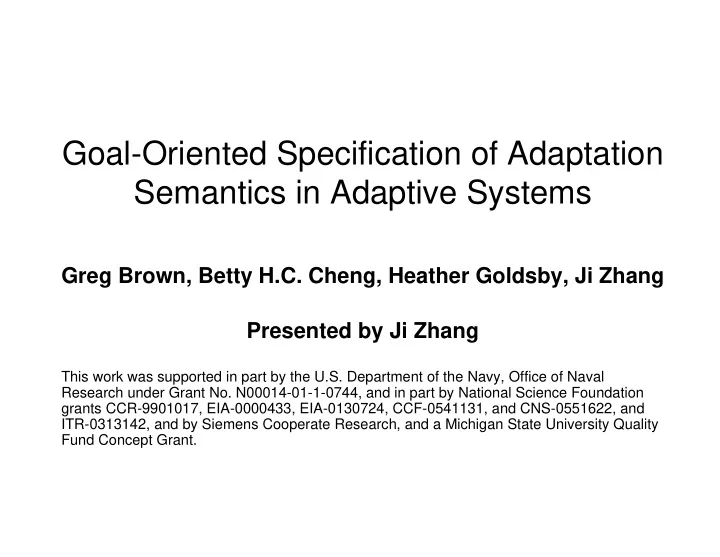

Goal-Oriented Specification of Adaptation Semantics in Adaptive Systems Greg Brown, Betty H.C. Cheng, Heather Goldsby, Ji Zhang Presented by Ji Zhang This work was supported in part by the U.S. Department of the Navy, Office of Naval Research under Grant No. N00014-01-1-0744, and in part by National Science Foundation grants CCR-9901017, EIA-0000433, EIA-0130724, CCF-0541131, and CNS-0551622, and ITR-0313142, and by Siemens Cooperate Research, and a Michigan State University Quality Fund Concept Grant.
Need for Dynamic Adaptation • Pervasive Computing. – Promises anywhere, anytime access to data and computing. • Autonomic Computing. – Promises self-managed and long-running systems that require only limited human guidance. Handheld/Wearable Computing Military Applications Sensor Networks
Tasks in Dynamic Adaptation assurance enabling decision- monitoring making
Proposed Approach • Goal-oriented specifications can aid in correct design of adaptive systems – Representation of adaptation semantics [JSS06] – Graphical wrapper for formal definition • Existing goal-oriented models – KAOS • Feather, van Lamsweerde, Fickas [Feather98] – Tropos/i* mixture • Lapouchnian, Mylopoulos [Yu05] – Either could have been used for graphically representing these adaptation semantics
Agenda • KAOS Goal-Oriented Notation • Adaptation Semantics Models • Summary and Future Work
KAOS – Goal Models • Use graphical objects to model system requirements [Dardenne93] – Goals Goal – OR-refinement – AND-refinement – Sequential annotation [Yu05] OR–refinement AND–refinement Sequential-refinement Goal 1 Goal 1 Goal 1 Goal 3 Goal 2 Goal 2 ; Goal 3 Goal 3 Goal 2
Operationalization • Requirements are modeled in terms of system goals – Requirements – Agents – Operations Goal 1 – Events Event 2 Requirement 1 Goal 2 output monitor performance Operation 1 Agent Event 1
A-LTL: Adapt Operator Extended LTL • Extends the Linear Temporal Logic with an adapt operator [JSS06]. Ω read as φ adapts to ψ with constraint Ω . φ → ψ φ ψ S S S S S S − + + k 1 0 1 k k 1 k 2 – Used to specify adaptation semantics
One-Point Adaptation target behavior source behavior adapt request – Initially behaves as source . – At one point after “adapt request”, starts to behave as target.
One-Point Adaptation Model adapt from source to target monitor agent performance in source ; in target request target output monitoring performance change adapt to target adapt to target agent
One-Point Adaptation Model Goal : Achieve [adapt_from_sourc_to_target] Concerns S SPEC , T SPEC , A REQ RefinedTo : in_source, in_target InformalDef : The program initially satisfies S SPEC . When a safe state is reached, the program starts to satisfy T SPE C adapt from source to target FormalDef: monitor agent performance in source ; in target request target output Goal : Achieve [in_target] monitoring performance change Concerns T SPEC , Goal : Achieve [in_source] request to target adapt to target agent Concerns S SPEC , Refines : adapt_from_sourc_to_target Refines : adapt_from_sourc_to_target InformalDef : The program satisfies T SPEC . InformalDef : The program satisfies FormalDef: T SPEC S SPEC . FormalDef: S SPEC
Guided Adaptation target behavior source behavior restrict condition adapt request – Initially behaves as source. – A condition restrict the program to reach a safe state. – Finally, the program behaves as target.
Guided Adaptation Model adapt from source to target ; adapt from source to restricted in target in source in restricted ; adapt to adapt to restricted target performance performance change agent request restricted monitor request target monitor output output performance performance request monitor agent request target restricted
Overlap Adaptation target behavior source behavior restrict condition adapt request – The source and target behavior may overlap. – A condition guides the program to reach a safe state.
Overlap adaptation model adapt from source to target ; adapt from source to overlap in target in source in overlap ; adapt to overlap adapt to target change agent request target request to overlap request request monitor agent target overlap
Summary • Goal-oriented specification of common adaptation semantics in KAOS notation • Graphical wrapper to formal A-LTL adaptation semantics • Benefits of formal specification as well as those of graphical representation – Ease of understanding – Tool support – Analyses
Future Work • Use of adaptation semantics in different application domains. • Goal-oriented decision-making • Goal-oriented modeling in the context of model-driven development of adaptive systems [ICSE06]
Acknowledgements • Members in the Software Engineering and Network Systems Laboratory at Michigan State University • SEAMS reviewers • Grants: This work was supported in part by the U.S. Department of the Navy, Office of Naval Research under Grant No. N00014-01-1- 0744, and in part by National Science Foundation grants CCR- 9901017, EIA-0000433, EIA-0130724, CCF-0541131, and CNS- 0551622, and ITR-0313142, and by Siemens Cooperate Research, and a Michigan State University Quality Fund Concept Grant.
Recommend
More recommend